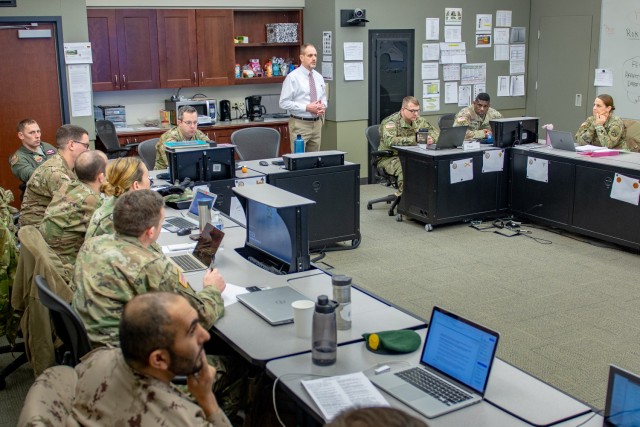By Sarah Hauck, The Army University Public Affairs Officer January 12, 2024
FORT LEAVENWORTH, Kan. — Distance learning and virtual classrooms have become commonplace across education within the Army thanks to technology improvement and innovation.
In about six months, The Army University’s Academic Technology Support Directorate has successfully supported more than 1,000 students within the university’s premiere course, Command and General Staff College, begin using the Army’s Azure Virtual Desktop.
AVD is the core platform that allows individuals to use their own computers as part of the Army’s larger initiative to support the use of personal devices to conduct government work. It allows users to access their Army.mil account and all Microsoft Office Suite applications to include Teams, which has become a staple component of education within The Army University, with only internet access, their CAC and any computer.
AVD meets students where they already are; on their personal devices, Maj. Robert Alsfelder, technical director for the ArmyU G6/ATSD explained.
“We learned from COVID, we need to be much more adaptable and agile,” Alsfelder said. “Using AVD allows for all of our students, no matter where they are from, to have the same educational experience.”
Like looking through a window, AVD allows users to see into their Army.mil account from anywhere — home, library, coffee shop.


In addition to added agility by eliminating the need for individuals to use government issued devices, AVD is a two-fold win for the university.
With the recent increase in students using personal devices during their courses at The Army University, networked computers within the classrooms would often go unused for a significant amount of time causing frequent and time-consuming issues for the G6 team and prolonged outages for students.
“AVD offers a considerably faster response to cybersecurity vulnerabilities or patches,” Alsfelder said. “Any new patch that comes out can be applied to every single AVD instance in a single action, rather than having to patch or update every single computer individually.”
Like many advances in technology, there is often some hesitation about its capabilities and longevity. Alsfelder said was it was no different for the students and faculty first introduced to AVD in August.
“Out of about 1,000 students, we only had a few indicate that they did not wish to bring a personal device, and many of those students have since made the switch once they saw the agility that their fellow classmates had,” he said. “Many of our staff have found it offers a similar kind of agility by giving them a full NIPR desktop from anywhere in the world, from any device, without having to haul around a government-furnished laptop that comes with a variety of physical security requirements (like not being able to leave it in a car while you run an errand, for instance).”
CGSC has a complex population that includes a large portion of students from other service branches, and other DoD entities. AVD requires an Army.mil account to connect to the applications and enable collaboration within classes, which created a unique obstacle for the ATDS team. However, continued work with AVD has connected nearly 60% of all sister service users to the program’s capabilities.
CGSC also has the largest population of majors, a majority of who are using AVD.
According to Alsfelder, the AVD Program representatives are encouraged by The Army University’s use of the program and how its users have the potential to impact it’s use across the force.
“We believe at least some of the students will take this capability with them as they go to be S3s and XOs throughout the Army and act as AVD champions themselves for 1,000 different units come this summer,” he said. “With any program like this, the biggest hurdle is always user adoption, and the way to overcome that is with users who believe in and encourage others to use the program. What better population to capture than 1,000 Army majors who will go on to be influential staff officers all throughout the Army?”
For academic year 2024, The Army University G6 is optimistic 100% of new students will begin using AVD. In the near future, the team will continue to work through streamlining the process for non-army entities to request and register for AVD as well as work with AVD to allow users printing capabilities.
